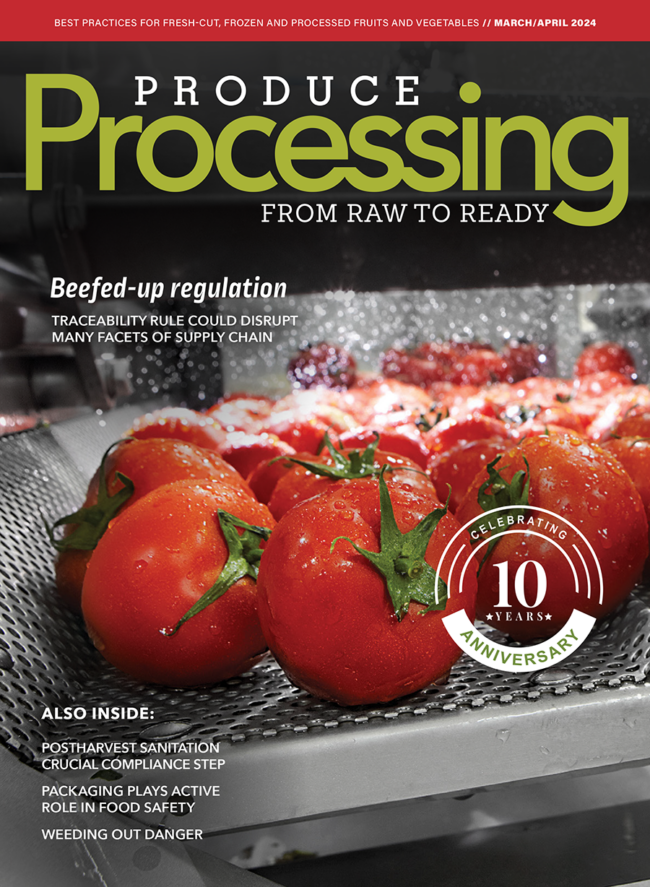Fresh produce in pet food a growing trend
By Kathy Gibbons | Contributing Writer
As people food goes, pet food is following.
Just as trends show consumers wanting products made with fresh ingredients, pet owners are also becoming more discerning about what they feed their animals.
Enter fresh produce.
Dana Brooks, president and CEO of the Pet Food Institute representing members who produce about 98 percent of U.S. pet food products, said vegetables and fruits play a part in evolving variations of dog and cat foods. Those ingredients contribute to a total pet food market that reached nearly $29 billion in sales in the U.S. in 2018.

“We are seeing a variation such as fresh … and organic offerings just as we’ve seen on the grocery store shelf,” Brooks said. “We mimic our pets’ diets to our diets and our needs. We’re seeing that shift. It’s the evolution of the pet food industry and how the food is manufactured and how we see a change in our relationship with our pets to the point that their food looks like our food.”
Brooks added that could mean fewer grains and fillers or simply the addition of such items as potatoes, sweet potatoes, legumes, lentils, carrots, beans, spinach and other fruits and vegetables.
“It may be replacing some of the grains,” she said. “It may be just an addition rather than a replacement to slightly offset maybe another protein or carbohydrate or a starch.”
Among others, Blue Buffalo Pet Products, purchased by General Mills in 2018, uses fruits and vegetables in various dry and canned pet foods. The J.M. Smucker Company’s Ainsworth Pet Nutrition also uses fresh ingredients like sweet potatoes, potatoes and other vegetables.
“There’s been an explosion in this category,” said Hanna Mandelbaum, who with business partner/chef Alison Weiner runs Evermore Pet Food producing dog foods made with restaurant-quality ingredients including fresh produce.
Healthy eating for cats and dogs
For Alex Jarrell, her own dog’s health problems were the spark for co-founding NomNomNow. The company was launched just a few years ago and now has thousands of customers in 48 states, with production facilities in California and Tennessee.
It all began when, after trying various remedies to boost her dog’s immune system, Jarrell began making her dog’s food based on a recipe provided by her veterinarian. It made all the difference in her dog’s health, she said.
Jarrell and three partners hired a board-certified veterinarian nutritionist to develop formulations that they stipulated had to be made from whole ingredients — some source of protein, fruits, vegetables and brown rice.
The produce is key to providing different types of nutrients that pets might not get from proteins, Jarrell said.
“We use everything,” she explained. “Like in our chicken recipe, we use spinach, sweet potatoes and yellow squash. In our pork recipes, we use green beans, kale, zucchini squash and mushrooms.
“In our beef recipe, we have carrots, potatoes and peas.”
Cat food variations include asparagus and cantaloupe, which Jarrell says do not go in dog food recipes.
“Melon is very palatable to cats,” she said. “It also provides nutrients they need to stay healthy, so the fruit and vegetable inclusion in a cat recipe is going to be much smaller than in a dog food recipe, because cats need a diet primarily of protein.
“The primary number one goal is nutrient value and secondary is palatability and flavor.”
In post 9/11 New York City, dogs — like people exposed to toxic dust after the World Trade Center attacks — were getting sick, Mandelbaum said. The now-deceased woman who started the forerunner of Evermore began formulating dog food in consultation with a veterinarian and extended her cancer-diagnosed dog’s life for six more years, Mandelbaum said.
Incorporated in 2009, the Brooklyn, New York-headquartered Evermore sources organic-only ingredients — with the exception of wild blueberries from Maine — to make dog food that it ships frozen to customers throughout the U.S. and makes available at retail in outlets primarily in the San Francisco Bay and New York City areas. Most of the produce they use comes in fresh form — carrots, kale and dandelion greens, for examples. Over time, however, the company has gravitated to purees (apples) and frozen (butternut squash, cranberries, parsley, blueberries) products to save on labor costs. The company contracts out production, but it sources ingredients directly.
While NomNomNow was dicing its own potatoes and sweet potatoes, they now pay to get it fresh cut.
“We used to back in the day dice everything ourselves,” Jarrell said. “Now we work with a company to dice it for us — primarily any vegetable that’s going to take a lot of time for us to actually hand cut ourselves.”
Sourcing opportunities
Using fresh produce has potential to help the produce industry find a market for seconds or culls — much in the way a company called RootLab touts the sustainability of its pet food products that include the use of, for example, cod parts that might normally go to waste. The bruised apple or blemished potato that doesn’t make it to prime time in the produce department or foodservice distribution, or some leftover cuttings from the fresh-cut plant might be perfectly suitable for use in pet food processing.
“While it may not be visually appealing, or dare I say, ugly produce, it still has value, taste and may have quality,” Brooks said. “Those are opportunities for us in the industry to be able to use those products that would otherwise be wasted.
“They’re perfectly safe and ready for market. It’s exciting to see how we are able to use those ingredients and reduce food waste.”
Many pet food processors source produce near their plants, she added.
“In California, it could come straight from the shipping house, it can be culled out … or it possibly could come from a cannery that there may be some products not used … or maybe an oversupply for some reason,” she said.
For Evermore and NomNomNow, it’s important to source ingredients from the same places that supply human food.
“We use restaurant suppliers — the same people restaurants go to for their foods,” Jarrell said.
Evermore’s model is similar.
“We’re getting the same kind of fresh, organic produce that people would be eating at the nice restaurants in L.A.,” Mandelbaum said. “Our produce is pretty much southern California for the fresh stuff, and the wild blueberries from Maine, a few things from Washington state and Oregon.”
In fact, to demonstrate the quality of their products, Mandelbaum and Wiener ate their dog food daily for a month.
“Basically, the things you hear about food for humans is true for dogs, too,” Mandelbaum said. “There’s a real focus on clean eating (and) a focus on being aware of where your food is coming from.”
(Top photo: Evermore Pet Food.)







